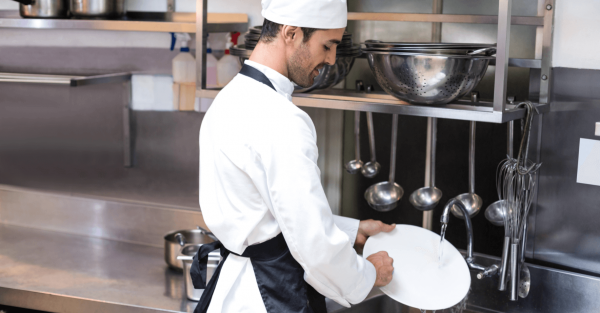A clean, hygienic commercial kitchen is essential for health and safety. With regular maintenance, commercial kitchen cleaning procedures are easy to implement and won’t be time-consuming.
There will be potential hazards in all commercial kitchens, such as grease and dirt on the floor and naturally builds up over time unless you regularly maintain the cleanliness. A good approach to cleaning commercial kitchens and avoiding a hazard is dividing the job into smaller tasks and ensuring your team is fully trained to do the job correctly. Here are the commercial kitchen cleaning procedures you need to know.
- What You'll Need
- Colour-coded Cleaning
- How Often Should Certain Kitchen Items Be Cleaned?
- How to Clean Hard Surfaces
- How to Clean Floors
- Why the Sink Must Be Cleaned Regularly
- How to Clean Bins
- Touchpoints
What You Will Need
To ensure you clean your commercial kitchen appropriately and within regulations, you’ll need to invest in the appropriate tools. These include:
- Mop and bucket
- Broom
- Dustpan and brush
- Paper towels or clean, lint-free towels or microfibre cloths
- Non-abrasive scrubbing pads
- Non-food contact brush or scouring pads
- Multi-purpose cleaner
- Floor cleaner
- Rubber gloves
Colour-coded Cleaning
Implementing colour-coded cleaning is vital to avoiding cross-contamination across each area of the kitchen. This will reduce the spread of germs that may cause disease and illness. For example, mops and cloths used to clean the restrooms shouldn’t also be used to clean the kitchen area.
A recommended colour-coded procedure to follow is yellow for kitchen and food prep, red for washrooms and toilets, green for the public area and blue for the restaurant and bar.
How Often Should Certain Kitchen Items Be Cleaned?
To ensure your kitchen area stays clean and safe to prepare food in, you should regularly clean all items regularly. Here’s how often you should do it:
- Surface and utensils - after each use
- Ovens - weekly depending on usage
- Sinks - between uses and throughout the day with frequent use
- Fridges and freezers - monthly
- Bins - weekly
It’s important to note the above is only a guideline. Depending on how frequently items are used, you may need to clean more often than recommended above.
How to Clean Hard Surfaces
Hard surfaces are a common area for bacteria and germs to live. If there are cracks in the surfaces, this creates an even greater environment for bacteria to thrive on. To combat this, use a deep cleansing, sanitising spray to clean your surfaces.
But first, to ensure all areas of the surface can be sufficiently cleaned, all storage items and loose debris should be removed. Always wear gloves and wash your hands after disinfecting surfaces. Spray the disinfectant on the surface and use paper towels to clean the surface. For a more intensive, deeper clean, leave the disinfectant on for 10 minutes.
To ensure the surface doesn’t get damaged, don't use scouring or scrubbing pads and only use non-abrasive cloths. After cleaning kitchen surfaces, any cloths used should be rinsed in warm water and stored in a bowl of disinfectant between uses.
How to Clean Floors
Clean floors are not only important for presentation, but also for kitchen safety. To do this properly, first sweep up any debris from the area. Next, place a wet floor sign in the area to warn passersby. Then, fill the mop bucket with seven litres of warm water and mix in 300ml of bleach. Using a clean mop, spread the liquid over the floor.
It’s best to concentrate on cleaner areas first, then move on to dirtier areas. If there are stubborn stains, take a stiff bristly brush and scrub the floor until any grease or stains are removed.
Why the Sink Must Be Cleaned Regularly
Although it may not seem immediately obvious to the eye, a kitchen sink can quickly become a thriving environment for germs which is why it requires regular cleaning. Not only that, but heavy grease and oil can also quickly clog sinks in kitchens, so it’s essential you keep the sink under control.
How to Clean Bins
If you don't clean bins regularly, they can quickly become a hotbed for germs and cause unpleasant smells in the kitchen. To avoid this, they should also be emptied often, so no wastage falls on the floor as this is a health and safety hazard.
Firstly, remove the bin bag from the bin, careful to watch if any liquid drops on the floor. This will need to be mopped up if it happens. Next, dispose of the full bin bags properly, recycling where possible.
Using a disinfectant, spray the bin on the inside and outside with a non-food contact scouring pad or brush. Rinse the bin with water and empty the dirty water. Leave the bin to air dry and place new bin bags in the containers.
Touchpoints
Touchpoints are areas that are touched by people frequently, such as lights and door handles. These areas harbour lots of germs, so it’s important they’re regularly cleaned, especially during the COVID-19 pandemic. These areas can easily be cleaned with disinfectant and wiping away.
Discover More About Kitchen Health and Safety Management
Maintaining good health and safety practices is vital to whether or not customers trust a restaurant and can stay open. To ensure your restaurant remains compliant while keeping everyone safe, we’ve listed everything you need to know about kitchen health and safety management in our latest guide. To get access to the unique insights, click the button below.

